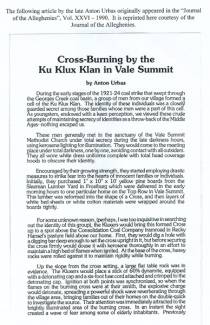Collection Name
About
Cross-Burning by the Ku Klux Klan in Vale Summit
by Anton Urbas
During the early stages of the 1921-24 coal strike that swept through the George's Creek coal basin, a group of men from our village formed a cell of the Ku Klux Klan. The identity of these individuals was a closely guarded secret among those families whose men were a part of this cell. As youngsters, endowed with a keen perception, we viewed these crude attempts of maintaining secrecy of identities as a throw-back of the Middle Ages-nothing escaped us.
These men generally met in the sanctuary of the Vale Summit Methodist Church under total secrecy during the late darkness hours, using kerosene lighting for illumination. They would come to the meeting place under total darkness, one by one, avoiding contact with all outsiders. They all wore white dress uniforms complete with total head coverage hoods to obscure their identity.
Encouraged by their growing strength, they started employing drastic measures to strike fear into the hearts of innocent families or individuals. Initially, they purchased 1" x 10" x 10' yellow pine boards from the Sleeman Lumber Yard in Frostburg which were delivered in the early morning hours to one particular home on the Top Row in Vale Summit. This lumber was reformed into the shape of a Cross, and then layers of white bed-sheets or white cotton materials were wrapped around the boards tightly.
For some unknown reason, (perhaps, I was too inquisitive in searching out the identity of this group), the Kluxers would bring this formed Cross up to a spot above the Consolidation Coal Company tramroad in Reeky Hansel's pasture field above our home. First, they would dig a hole with a digging bar deep enough to set the cross upright in it, but before securing the cross firmly would douse it with kerosene thoroughly in an effort to maintain a high bed of flames when ignited. At the base of the cross, heavy rocks were rolled against it to maintain rigidity while burning.
Up the slope from the cross setting, a large flat table rock was in evidence. The Kluxers would place a stick of 60% dynamite, equipped with a detonating cap and a six-foot fuse cord attached and crimped to the detonating cap. Ignition at both points was synchronized, so when the flames on the burning cross were at their zenith, the explosive charge would detonate, spreading a powerful shock wave reverberating through the village area, bringing families out of their homes on the double-quick to investigate the source. Their attention was immediately attracted to the brightly illuminated area of the burning cross. In an instant the sight created a wave of fear among some of elderly inhabitants. Previously ...
In the Journal of the Alleghenies, published by the Council of the Alleghenies.
